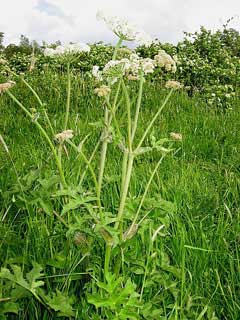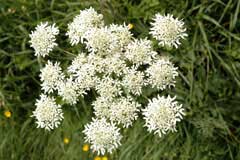 |
|
http://commons.wikimedia.org/wiki/User:Rasbak |
 |
| http://www.commanster.eu/commanster.html |
Translate this page:
Summary
Physical Characteristics

 Heracleum sphondylium is a BIENNIAL/PERENNIAL growing to 1.8 m (6ft).
Heracleum sphondylium is a BIENNIAL/PERENNIAL growing to 1.8 m (6ft).
See above for USDA hardiness. It is hardy to UK zone 5 and is not frost tender. It is in flower from June to September, and the seeds ripen from July to October. The species is hermaphrodite (has both male and female organs) and is pollinated by Bees, flies. The plant is self-fertile.
It is noted for attracting wildlife.
Suitable for: light (sandy), medium (loamy) and heavy (clay) soils. Suitable pH: mildly acid, neutral and basic (mildly alkaline) soils. It can grow in full shade (deep woodland) semi-shade (light woodland) or no shade. It prefers moist soil.
UK Hardiness Map
US Hardiness Map
Synonyms
Plant Habitats
Woodland Garden Dappled Shade; Shady Edge; not Deep Shade; Meadow; Hedgerow;
Edible Uses
Edible Parts: Leaves Root Shoots Stem
Edible Uses: Sweetener
Stem and young shoots - raw or cooked[5, 7, 9, 17]. Used as a green vegetable, when harvested just as they are sprouting from the ground they are somewhat like asparagus in flavour[183]. The rind is somewhat acrid[115]. The leaf stems are tied in bundles and dried in the sun until they turn yellow[238]. A sweet substance resembling sugar forms on the dried stems and is considered to be a great delicacy[2, 115, 183, 238]. The peduncles, before flowering, can be eaten as a vegetable or added to soups[183]. Root - cooked. It is usually boiled[7].
References More on Edible Uses
Medicinal Uses
Plants For A Future can not take any responsibility for any adverse effects from the use of plants. Always seek advice from a professional before using a plant medicinally.
Antidiarrhoeal Antipsoriatic Aphrodisiac Digestive Expectorant Sedative
The roots and the leaves are aphrodisiac, digestive, mildly expectorant and sedative[7, 9, 238]. The plant is little used in modern herbalism but has been employed in the treatment of laryngitis and bronchitis[9, 238]. A tincture made from the aerial parts of the plant has also been used to relieve general debility, though it is uncertain how it works[7, 238]. The plant is harvested as it comes into flower and can be dried for later use[9].
References More on Medicinal Uses
The Bookshop: Edible Plant Books
Our Latest books on Perennial Plants For Food Forests and Permaculture Gardens in paperback or digital formats.

Edible Tropical Plants
Food Forest Plants for Hotter Conditions: 250+ Plants For Tropical Food Forests & Permaculture Gardens.
More

Edible Temperate Plants
Plants for Your Food Forest: 500 Plants for Temperate Food Forests & Permaculture Gardens.
More

More Books
PFAF have eight books available in paperback and digital formats. Browse the shop for more information.
Shop Now
Other Uses
References More on Other Uses
Cultivation details
A very easily grown plant, succeeding in any ordinary garden soil[1, 238], doing best in moist soils or deep woodland[1]. Grows well in full sun or partial shade[238]. This species contains a large number of sub-species. Some, but by no means all of them, can cause various problems as detailed at the top of this record. Subspecies transylvanicum, pyrenaicum, montanum, orsinii and alpinum are distinctly phototoxic, subspecies sphondylium and sibiricum are not phototoxic whilst subspecies granatense and ternatum vary in their toxicity[65]. A good bee plant[108]. For polyculture design as well as the above-ground architecture (form - tree, shrub etc. and size shown above) information on the habit and root pattern is also useful and given here if available. The plant growth habit is a clumper with limited spread [1-2]. The root pattern is a tap root similar to a carrot going directly down [1-2].
References Carbon Farming Information and Carbon Sequestration Information
Temperature Converter
Type a value in the Celsius field to convert the value to Fahrenheit:
Fahrenheit:
The PFAF Bookshop
Plants For A Future have a number of books available in paperback and digital form. Book titles include Edible Plants, Edible Perennials, Edible Trees,Edible Shrubs, Woodland Gardening, and Temperate Food Forest Plants. Our new book is Food Forest Plants For Hotter Conditions (Tropical and Sub-Tropical).
Shop Now
Plant Propagation
Seed - sow mid to late spring or early autumn in situ. Division in autumn.
Other Names
If available other names are mentioned here
Native Range
TEMPERATE ASIA: China, Eastern Siberia, Far East, Japan, Kazakhstan (southeast), Kyrgyzstan, Mongolia, Russian Federation-Eastern Siberia, Russian Federation-Far East, Russian Federation-Western Siberia, Western Siberia,Turkey. EUROPE: Denmark, Finland, United Kingdom (U.K.), Ireland, Norway, Sweden, Austria, Belgium, Switzerland, Czech Republic, Germany, Hungary, Netherlands, Poland, Slovakia, Russian Federation-European part, European part, Belarus, Estonia, Lithuania, Latvia, Moldova, Ukraine (incl. Krym), Albania, Bulgaria, Bosnia and Herzegovina, Greece, Croatia, Italy (incl. Sicily), North Macedonia, Montenegro, Romania, Serbia, Slovenia, Spain, France, Portugal, AFRICA: Morocco.
Weed Potential
Right plant wrong place. We are currently updating this section.
Please note that a plant may be invasive in one area but may not in your area so it's worth checking.
Conservation Status
IUCN Red List of Threatened Plants Status :

Growth: S = slow M = medium F = fast. Soil: L = light (sandy) M = medium H = heavy (clay). pH: A = acid N = neutral B = basic (alkaline). Shade: F = full shade S = semi-shade N = no shade. Moisture: D = dry M = Moist We = wet Wa = water.
Now available:
Food Forest Plants for Mediterranean Conditions
350+ Perennial Plants For Mediterranean and Drier Food Forests and Permaculture Gardens.
[Paperback and eBook]
This is the third in Plants For A Future's series of plant guides for food forests tailored to
specific climate zones. Following volumes on temperate and tropical ecosystems, this book focuses
on species suited to Mediterranean conditions—regions with hot, dry summers and cool, wet winters,
often facing the added challenge of climate change.
Read More
Expert comment
Author
L.
Botanical References
17200
Links / References
For a list of references used on this page please go here
Readers comment